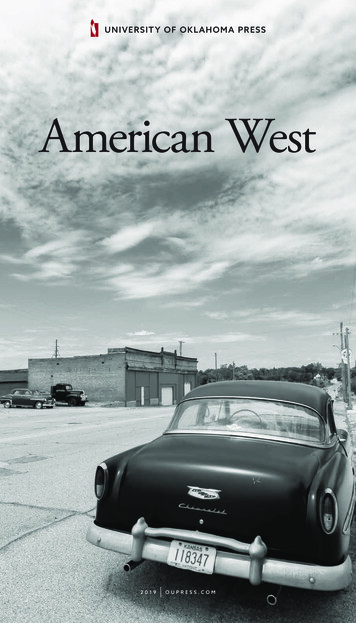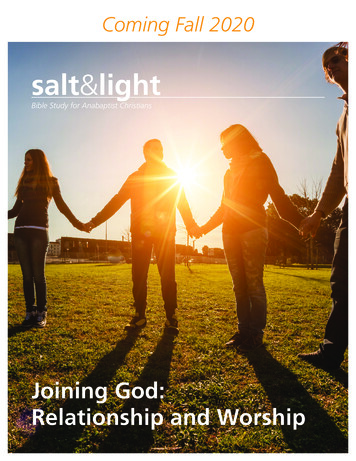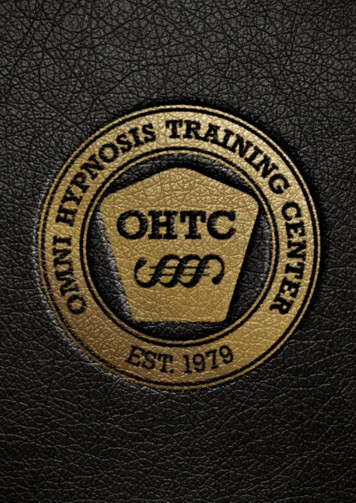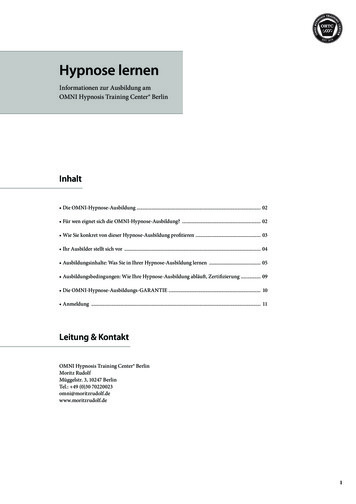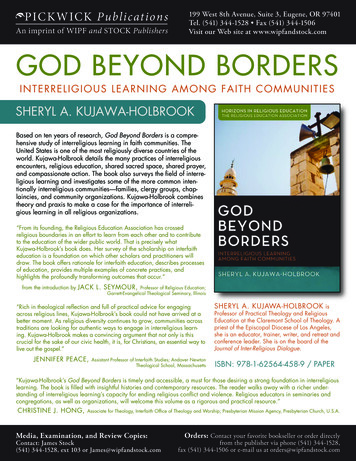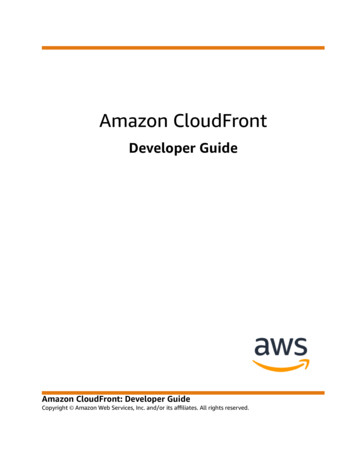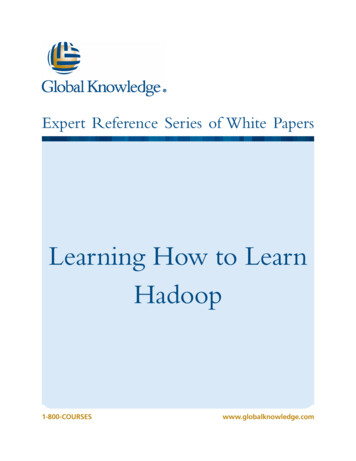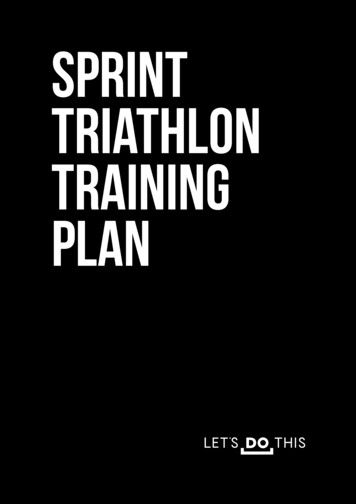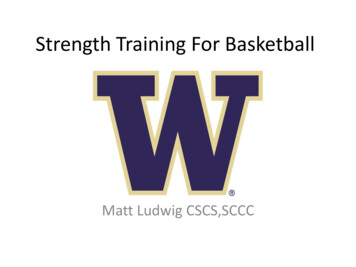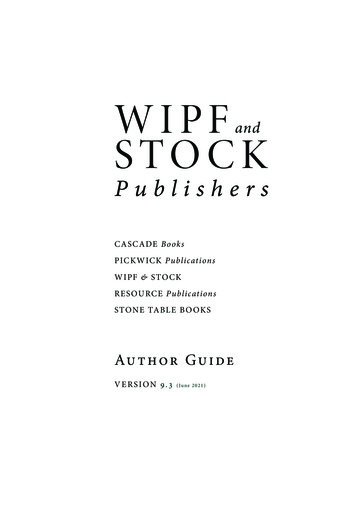
Transcription
WIPFSTOCKandPublishersC AS C ADE B ooksPIC K W IC K PublicationsW IPF & STO C KRES OU RC E PublicationsSTONE TABL E B O OKSAu t h o r G u i d eVERSION 9.3( Ju n e 2 0 2 1 )
CONTENTSIntroduction 1History and Mission 2Our Publishing Model 2Imprints 3The Publishing Process 4Workflow Overview 4Stage 1:Submitting a Proposal 5Stage 2:Contracting 6Stage 3:Permissions 7Quoting Previously Published Materials 7Bible Translation Permissions 9Resources on Permission and Fair Use 10Stage 4:Preparing a Final Manuscript 11Before You Begin 11Special Instructions for Works of Poetry and Fiction 12Step #1: Formatting of Your Manuscript 13Step #2: House Style Guidelines 15Step #3: Inserting Typesetting Tags 17Step #4: The Use of Tables and Charts; Images and Illustrations 19Step #5: Sending Your Final Files 21Step #6: Guidelines for Multi-Authored Works 23Stage 5:Format Check 24Stage 6:Editorial 25Stage 7:Typesetting 26Stage 8:Production 28
Marketing 29The Role of Marketing 29Distribution and Availability 29Conferences and Advertising 30The Role of the Author 30Marketing and Promotion 31Ordering / Policies / Contact Information 32Ordering 32Policies 33Contact Information 34Appendices 35Appendix A:Sample Permissions Letter 35Appendix B:Footnotes and Bibliography 36Appendix C:Abbreviations of Scripture and Other Ancient Sources 43Appendix D:Abbreviations of Reference Works 44Appendix E:Common Diacritical Marks 46Appendix F:Working with Your Typesetter 47Appendix G:Revising and Publishing Your Dissertation 49Appendix H:Indexing 50Appendix I:Reprinting 52Appendix J:Subvention Fees for Pickwick Volumes 53Appendix K:House Style Guide 54Glossary of Publishing Terms 60Frequently Asked Questions 62Editorial Questions 62Ordering and Marketing Questions 58
INTRODUCTIONThank you for considering publication with Wipf and Stock Publishers. We are one ofthe fastest-growing trade and academic publishing houses in the United States. We are acompany dedicated to publishing excellence and superior publisher-author relations. ThisAuthor Guide is the standard reference for authors and editors as they prepare for and movethrough the publishing process at Wipf and Stock Publishers.Whether you are a first-time author or have already published a book here or elsewhere,it is important to be aware of the particular steps taken at Wipf and Stock Publishers to publish your book. Some of these steps are unique to our company, and some vary within ourcompany from imprint to imprint. On the pages that follow you will find: an overview of our history and publishing model; a step-by-step guide to our publishing process, with detailed instructions outlining your specific responsibilities as an author; an overview of our marketing strategy and your role in the promotion of yourbook; several helpful appendices, including a Glossary of Publishing Terms and a listof Frequently Asked Questions.This Author Guide was designed specifically to answer questions you may have about publishing a book with Wipf and Stock Publishers. A thorough reading of the Author Guidewill inform you of how our company works, what steps are taken to publish your book,and what role you have in this process. Please note: this guide is subject to change withoutnotification.We look forward to partnering with you to bring your work to publication.1
HISTORY AND MISSIONEstablished in 1995, Wipf and Stock Publishers started as a joint venture between John Wipfof The Archives Bookshop in Pasadena, California, and Jon Stock of Windows Booksellersin Eugene, Oregon. As booksellers with over thirty years of industry experience betweenthem, they noticed a number of changes in the academic book business. They observed anincrease in both the price of new academic books and the rate they were going out of print.They also experienced an increased demand for books that were unable to meet publishers’requirements for remaining in print.In an attempt to address these dilemmas, Wipf and Stock Publishers was created. Byspecializing in short book runs, John Wipf and Jon Stock were not only able to supply theirown bookstores with the classic theology, biblical studies, and church history titles forwhich they continued to receive requests, they also found themselves fulfilling the requestsof professors and textbook managers who needed out-of-print texts for classroom use.Today Wipf and Stock Publishers has over eleven thousand titles in its inventory, addingover two hundred reprints per year.Over the course of working with various authors and professors, Wipf and Stock Publishers also began to receive requests to publish new books. In the early 2000s we begandeveloping the editorial and acquisitions program into the thriving and succesful ventureit has become today—we publish over five hundred new publications each year under ourdifferent imprints: Cascade Books, Pickwick Publications, Wipf & Stock, Resource Publications, Stone Table Books, and Front Porch Republic.OUR PUBLISHING MODELLocated in the heart of downtown Eugene, Oregon, Wipf and Stock Publishers has established itself as a leader in publishing. With a staff of more than fifty employees, Wipf andStock has consolidated every aspect of the publication process into one location. This meansthat every stage of your book’s production—acquisitions, editing, typesetting, design, printing, binding, shipping, marketing, and customer service—is managed on-site. Furthermore,by utilizing digital imaging and printing technology, Wipf and Stock has developed an innovative method of short-run production that allows for the fulfillment of orders within twoto five business days. The combination of this technological innovation with a full, on-sitepublication staff allows us to do things that more traditional publishing houses are not in aposition to do. Our unique publishing model allows us to: accept book projects based on merit rather than a book’s projected sales; ensure that your book will always be in print and available for ordering; have your book published and ready for ordering as early as nine to eighteenmonths from the time we receive your final manuscript.In striving to combine a cutting-edge publishing model with traditional academic excellence,Wipf and Stock Publishers is able to expeditiously produce affordable books of enduring value.2
IMPRINTSCASCADE B ooksCascade Books publishes new works in religion that combine academic rigor with broadappeal and readability. Specializing in a wide array of disciplines, Cascade Books promotesconversation essential to the academy and the life of faith communities with books in theology, biblical studies, religious history, spirituality, ministry, cultural criticism, and more.PICKWICK Publication sBooks written for and by the academy. The scholarly imprint of Wipf and Stock Publishers,Pickwick specializes in monographs, dissertations, and collections of conference papers inthe fields of religion, philosophy, and related disciplines. (Manuscripts accepted for Pickwickare subject to subvention fees. To learn more about this, please see Appendix J).WIPF & STO CKEstablished in 1995, Wipf and Stock Publishers has been publishing new books that servethe church and academy under our general imprint, Wipf & Stock. The publishing focus ofWipf & Stock is broad, offering titles in biblical studies, theology, ethics, church history, linguistics, history, classics, philosophy, preaching, and church ministry. Of course, the Wipf& Stock imprint is also well known for its wide range of essential reprints, including thework of some of the most substantial names in theology, biblical studies, and church history. (for more on reprints, see Appendix I, “Reprinting”).RESOURCE Publication sSince its inception, Resource Publications has been our imprint for both trade and academicworks within a wide range of subject areas and target markets. Now listing over fifteen hundred active titles, Resource Publications publishes within multiple genres including religion,psychology, fiction, poetry, memoir, sermon collections, biographies, and more.STONE TABLE B ooksStone Table Books had its start in Adelaide, South Australia, specializing in fantasy and science fiction books for all ages. It specializes in new authors and authors with unique storyideas. The imprint name is inspired by an image in C. S. Lewis’ The Lion, the Witch and theWardrobe and indicates its interest in publishing books with spiritual themes and imagery,though it also publishes many mainstream novels.To learn more about these imprints, visit us at wipfandstock.com.3
THE PUBLISHING PROCESSMoving from proposal to final publication is a partnership between authors and a host ofother characters: editors, copyeditors, marketing personnel, designers, proofreaders, managing editors, typesetters, printers, indexers, and customer service representatives. In orderto better understand the different stages, roles, and responsibilities within our publishing workflow, please review the following charts and stage descriptions. (Throughout thisguide, terms that may be new or unfamiliar are listed in the glossary and have been markedin bold in the text.)Workflow Overview1Submitting a Proposal2Contracting3Permissions4Preparing a Final Manuscript5Format Check6Editorial7TypesettingaFirst PagesbAuthor ProofcAuthor ApprovaldIn-House RevieweFinal Pages8ProductionfIndexing4
Stage 1Submitting a ProposalThe first stage of the publishing process is to submit a completed Proposal Form provided byour editorial department. The purpose of the proposal is to give our editorial department asuccinct description of your book that allows them to make a decision about publishing it.In addition to requesting proposals from potential authors, Wipf and Stock Publishers alsowelcomes unsolicited manuscripts.A Proposal Form can be acquired directly from our website, wipfandstock.com,or by contacting us at proposal@wipfandstock.comPlease email all completed proposal forms to proposal@wipfandstock.com.5
Stage 2ContractingThe second stage of the publishing process is contracting. This stage involves several backand-forth exchanges between the author and Wipf and Stock Publishers.When a proposal has been accepted, we will issue a contracting document andsample contract. First, please read through the sample contract to become familiar with theterms that will be included in your contract. Second, when you are ready to accept our offer of publication, please complete and submit the contracting document. Once we receivethis document we will issue you a contract, a W-9 form (if applicable), and contributoragreements when required. At this time we will also issue the Editorial (EQ) and Marketing (MQ) Questionnaires, which are to be submitted with the final manuscript files.This stage is completed when the contract, W-9, and all contributor agreements havebeen signed and submitted to Wipf and Stock Publishers.Contributor Agreements: If you are the editor of a multi-authored work, you will beresponsible for sending, receiving, and returning all signed contributor agreements provided along with your contract. Missing contributor agreements will delay the publicationof your project. Please note that this can be a difficult and time-consuming task, one that isakin to “herding cats” as they say.NOTE: No work will be done on your manuscript until the contracting stage is complete.Royalty Payment Schedule: Royalties are distributed once per year. Our schedule is basedon the author’s last name, or in the case of multi-authored works, on the last name of theauthor listed first.A–E: FebruaryF–L: AprilM–R: JulyS–Z: October6
Stage 3PermissionsThe third stage of the publishing process is to ensure that any previously published materialused in your book either falls within the standards of “fair use” or can be republished withpermission. Materials that are likely to require permission include: extensive quotations of prose; poetry (quotations of any length); songs (quotations of any length); comic strips (images or quotations of any length); illustrations, photos, diagrams, or charts (including those obtained from theInternet).As the author it is your responsibility to secure the necessary permissions for the publication of your manuscript. You can obtain permission to include previously published material in your book by contacting the publisher of the source from which you are quoting orhave obtained photos or illustrations. We have provided a sample permissions letter foryou to use as a template (see Appendix A). When acquiring permissions, please be sure toobtain rights for print and electronic editions.Quoting Previously Published Materials:Copyright, “Fair Use,” and Permission FeesThe doctrine of “fair use” articulates that there are limits to the protection of copyright. Ifyour use falls within fair use (therefore not requiring permission) it still needs to be acknowledged and credited. If it goes beyond fair use and requires permission from the copyright administrator (usually a publisher), it is your responsibility to request (and often payfor) that permission. You also need to notify us, as your publisher, of your use of that copyrighted material, send us copies of the permissions you have requested and received, andindicate how it should be credited. If you have used such materials and want more guidanceon fair use and copyright, read the principles below. If you have questions, feel free to contact your editor at Wipf and Stock Publishers.Keep in mind that US copyright laws changed dramatically in 1998 with the CopyrightTerm Extension Act (also known as the Sonny Bono Law). Currently, any US work published in 1925 and earlier is in the public domain. Works published during the period of1923–1963 needed to have their copyright renewed (to check this, refer to the Resources onPermission and Fair Use at the end of this section). Copyrighted works published in 1964and after are protected for ninety-five years after the publication date.While there are general principles of fair use, the gray areas are large. However, US lawstates that the use of copyrighted materials “for purposes such as criticism, comment, news7
reporting, teaching (including multiple copies for classroom use), scholarship, or research,is not an infringement of copyright” (US Code, Title 17, Chapter 1, §107).Poetry and song lyrics are particularly problematic since the law is especially protectiveof them, and even a brief quotation generally represents a large percentage of the whole.These should be avoided at all costs. The estates of certain authors are particularly anxiousto litigate to protect their rights—the estates of T. S. Eliot and W. H. Auden are the mostfamous examples.In quoting copyrighted materials, The Chicago Manual of Style (CMOS) points to thefundamental fair use issue of “proportionality.” There is not a certain number of words thatis the cut-off for needing permission; you need to gauge the proportion of your quotationsto the size of the overall work from which you are quoting. If you quote 300 words from anessay that is 3,000 words, you are using 10 percent of the work, and this is generally unacceptable. But if you quote 300 words from a book that has 400 words per page and is 300pages (120,000 words), you would be quoting .25 percent. The four factors listed in the USlaw for evaluating fair use (and thus not needing permission) are:1“The purpose and character of the use, including whether such use is of a commercial nature or is for nonprofit educational purposes.”2“The nature of the copyrighted work” (viz., poem, song, article, essay, book).3“The amount and substantiality of the portion used in relation to the copyrightedwork as a whole.”4“The effect of the use upon the potential market for, or value of, the copyrightedwork” (CMOS 4.84). In other words, if you have a substantial portion of the textof a poem by W. H. Auden, the reader of your book would not have to buy one ofAuden’s books to have access to it.The Stanford University website (see resources at the end of this section) suggests askingtwo questions relevant to the first point:1“Has the material you have taken from the original work been transformed byadding new expression or meaning?”2“Was value added to the original by creating new information, new aesthetics,new insights and understandings?”CMOS also mentions the following principles of quotation and fair use: “Transcribe accurately and give credit to the original source” (CMOS 4.84). Do not quote out of context “in such a way as to make the author of the quotedpassage seem to be saying something opposite to, or different from, what was intended” (CMOS 4.84). “Courts, not publishers, adjudicate fair use” (CMOS 4.85). “Use of any literary work in its entirety—a poem, an essay, an article from a journal—is hardly ever acceptable” (CMOS 4.86).8 “As a general rule, one should never quote more than a few contiguous paragraphsof prose or lines of poetry at a time or let the quotations, even if scattered, begin toovershadow the quoter’s own material” (CMOS 4.86).
“Quotations or graphic reproductions should not be so substantial that they substitute for, or diminish the value of, the copyright owner’s own publication” (CMOS4.86). “Proportion is more important than the absolute length of a quotation” (CMOS4.86). “Traditional copyright doctrine treats extensive paraphrase as merely disguisedcopying” (CMOS 4.89). “The US Supreme Court has held that requesting permission should not be regarded as an admission that permission is needed” (CMOS 4.93).The reason CMOS recommends not requesting permission for something you reasonablyjudge is fair use is that it diminishes the doctrine of fair use and bogs down the whole publishing process.For a model of a letter requesting permission to use copyrighted material, see CMOS4.96 and fig. 4.3. Publishers will generally require a fee of 50– 300 depending upon theword count of the quotations and the type of publication.Bible Translation Permissionsrevised standard version (RSV) & new revised standard version (NRSV)500 verses or fewer, no permission required, but a notice of copyright must appear on the copyright page (for more details see https://nrsvbibles.org/index.php/licensing). More than 500 verses, permission required. Direct permissions requests to NRSVcopyright@mosaicrights.com.new international version (NIV) & today’s new intl version (TNIV)500 verses or fewer, no permission required, but a notice of copyright must appear on thecopyright page (for more details see rect permissions requests to ZPermissions@zondervan.com.new american standard bible (NASB)500 verses or fewer, no permission required, but a notice of copyright must appear on thecopyright page (for more details see www.lockman.org).new american bible (NAB)5000 words or fewer, no permission required, but a notice of copyright must appear on thecopyright page (for more details see http://www.usccb.org/nab/permissions). Direct permissions requests to nabperm@usccb.org.tanakh: the holy scriptures: the new JPS translation according to thetraditional hebrew text (NJPS)250 words or fewer, no permission required, but a notice of copyright must appear on thecopyright page (see http://www.nebraskapress.unl.edu/pages/about rights.aspx for details;downloadable permission form to be mailed or faxed).9
new jerusalem bible (NJB)All permissions must be secured in writing (see http://www.randomhouse.com/about/permissions.html and E: If you are using a translation other than those listed above, please perform anInternet search for the permissions for that translation in order to find out what yourspecific translation’s publisher has deemed fair use and what will require permission,along with the specific notice of copyright.Resources on Permission and Fair UsebooksBanis, Robert J. Copyright Issues for Librarians, Teachers & Authors. Chesterfield, MO:Science & Humanities, 2001.Chicago Manual of Style. 17th ed. Chicago: University of Chicago Press, 2017.Patry, William F. The Fair Use Privilege in Copyright Law. 2nd ed. Washington, DC: Bureau ofNational Affairs, 1995.Strong, William S. The Copyright Book: A Practical Guide. 5th ed. Cambridge: MIT Press,1999.Wilson, Lee. Fair Use, Free Use, and Use by Permission: How to Handle Copyrights in AllMedia. New York: Allworth, 2005.websitesCopyright and Fair Use Overview (Stanford University Libraries),http://fairuse.stanford.edu/Copyright and Fair Use Overview/index.html.Copyright Information Center (Cornell University), https://www.copyright.cornell.edu/.US Copyright Office: Copyright Monographs Database since gi?DB local&PAGE First.US Catalog of Copyright Entries (Renewals), http://www.ibiblio.org/ccer/.“Copyright Term and the Public Domain in the United in.“How Can I Tell Whether a Copyright Was Renewed?” (UPenn “Online Books wals.html.Copyright Renewal Records 1950–1977 (UPenn “Online Books Michael E. Lesk Copyright Renewal Search Engine,http://www.scils.rutgers.edu/ lesk/copyrenew.html.10
Stage 4Preparing a Final ManuscriptNow that your book is under contract, you have secured all of the necessary permissions,and you have completed the writing of your manuscript, it is time to submit a final manuscript to Wipf and Stock Publishers. Before this can happen, however, there are severalsteps you need to take to ensure that your manuscript has been properly prepared and isready to submit to us.Step #1: Formatting your manuscriptStep #2: Conforming the manuscript to our house styleStep #3: Inserting tags for the typesetter (“tagging” the manuscript)Step #4: Preparing any tables and charts; images and illustrationsStep #5: Properly organizing and naming your final files for submissionStep #6: Guidelines for multi-authored worksBefore You BeginIn what follows we have provided in-depth instructions for each step of this preparationprocess. However, before you begin we ask that you consider the following notes:Note 1: Once a final manuscript has been submitted it is complete. After receipt of yourfiles, substantive changes to your manuscript will not be accepted unless solicited by andcoordinated with your editor. You will receive first pages of your book after it has beentypeset; this will not be a time to make changes to the writing of your manuscript.Note 2: The formatting directions that follow assume authors are using Microsoft Word.If you are using another program and are unable to convert your files into a .doc or .rtf fileformat, contact our Managing Editor, Matt Wimer, at mwimer@wipfandstock.com.Note 3: In order to aid you in following these steps, we recommend that you turn on the“Reveal Formatting” feature that allows you to see hidden characters in your word processor. In Microsoft Word you can do this by selecting “Reveal Formatting” under the ViewMenu or by selecting the “Show” button in the Standard Toolbar:Note 4: Please be sure to fill out the Manuscript Preparation Overview in the providedEditorial Questionnaire that was sent to you in the same email that included the MarketingQuestionnaire. This is where you will catalog information on essential components of yourmanuscript such as typesetting tags, images, special words and phrases, and any uniquelayout issues. The Editorial Questionnaire is meant to be an aid to both the editorial andtypesetting departments as they work with your manuscript.11
Note 5: House Style ReferencesFor matters of style and documentation we follow: The Chicago Manual of Style. 17th ed. Chicago: University of Chicago Press,2017. Hereafter cited as CMOS.For matters of ancient and modern abbreviations, including biblical references, we follow: Alexander, Patrick, et al., eds. The SBL Handbook of Style: For AncientNear Eastern, Biblical, and Early Christian Studies. 2nd ed. Peabody, MA:Hendrickson, 2014. Hereafter cited as SBLHS.For general matters of spelling we follow: Webster’s Third New International Dictionary and its chief abridgment,Merriam-Webster’s Collegiate Dictionary. Merriam-Webster’s online dictionaryis quite useful as well: http://www.merriam-webster.com.Note to non-US authors: please use American spellings rather than British spellingsthroughout your manuscript (e.g., summarize, not summarise).Special Instructions for Works of Poetry and FictionWorks of Poetry and Fiction may not include some of the more complex elements noted inthe next few pages. However, please do read through Steps #1–6 to ensure your manuscriptis formatted correctly. Essential components are:Works of Poetry Insert page break between poems (Step #1) Tag poem titles with [A] (Step #3) Tag and format images (if necessary, Step #4) Submitting final files (Step #5)Works of Fiction Insert page break between chapters (Step #1) Tag and format images (if necessary, Step #4) Submitting final files (Step #5)12
Step #1: Formatting of Your ManuscriptBecause the typesetter needs to extract the raw, unformatted text from your manuscriptfiles and place it within a typesetting program, the following steps will ensure that all unnecessary formatting will be removed. If there are specific formatting elements you want toappear in your book (numbered lists, block quotations, images, etc.) these should be communicated to the typesetter through the insertion of typesetting tags, which is explained inStep #3: Inserting Typesetting Tags.1. Manuscript File Structure: Create one file for the front matter (see Step #5 for the order) Compile all chapters into one filea. You must insert a Page Break between chapters (for works of poetry, insert a Page Break between poems). (Please note: do not be concernedwith your footnote numbering and whether it restarts at each chapteror is continuous; this will be corrected at typesetting.) To do this, pleaseuse the following method:i. Insert page breaks between chapters by using the drop-downmenu insert break page break. Create one file for all of the back matter (appendixes, glossary, etc. if necessary) Create one file for the bibliography2.Fonts: Use Times New Roman for main body text. For Greek or Hebrew please use the SBL Greek or SBL Hebrew* fonts providedby the Society of Biblical Literature. These are available online and may bedownloaded for free .aspx). If the book is intended for general readership, transliterate Hebrew, Greek, andother alphabets, and set transliterations in italics.*NOTE: Greek and Hebrew fonts must be unicode. Another acceptable font isTimes New Roman. BibleWorks, SP Legacy fonts, and other non-unicode fontscannot be used in eBook formats and will result in your book being left out ofAmazon Kindle, iBooks, etc. For manuscripts with Syriac, use the Serto Jerusalemfont which can be downloaded at nts.html.13
3.Spacing: Do not leave extra space (blank lines) between paragraphs unless a break mustappear in the printed version. Do not leave extra space (blank lines) at the end of chapters or poems.4.Special Character Formatting: If you have used underlining or boldface for emphasis or to set apart foreignwords, change all these to italics. Underlining is acceptable only for purposes oftextual criticism and translation comparison. Please consult with your editor. Do not use ALL CAPS in the text for emphasis or to format your chapter titles,headings, or elements of your front matter. ALL CAPS or small caps are only tobe used for certain words that require this format (e.g., lord, am, pm, YHWH,etc.). Please list these words in your Editorial Questionnaire.5.Paragraph indentation, tabs, and hard returns: To properly indent paragraphs, either use tabs or use the formatting palette inWord to set a first line indentation value to .5in. Do not use a mix of tabs andindentation. . . subjection to it, nor use of the sacraments” (Article XXVIII).The exercise of church discipline was thus a well-established part of the Reformedtradition as members of various strands of that tradition migrated to America in the 17th andeighteenth centuries. Illustrative of the early American Presbyterian church’s exercise . . .Note: paragraphs after extracts that are a continuationof paragraphs before extracts should not be indented. Do not use tabs to indent runover lines in flush-and-hang (hanging indentation) style.Ahlstrom, Sydney E. A Religious History of the American People. New Haven: Yale» University Press, 1972.Aldridge, Alfred Owen. Benjamin Franklin and Nature’s God. Durham, NC: Duke» University Press, 1967.Instead, leave it in paragraph form. The typesetter will set the hanging indent format.14
Step #2: House Style Guidelines1. Footnote and Bibliography Style:Our house style is to use short-form footnote citations with a comprehensive bibliography. Notes should be shortened to: author’s last name, short title, and pagenumbers.Example: Smith, Smith’s Book of Reverent Reflections, 113.The various forms of documentation are covered in The Chicago Manual of Style(17th ed.), but see Appendix B for guidance on footnotes and bibliographic entries,including the basic forms and a sample bibliography.NOTE: Use the Insert Footnote function in your word processor to create footnotes.NOTE: The use of endnotes or in-text citations must be approved by your editor.2. Serial comma or Oxford comma:Items in a series are normally separated by commas. When a conjunction joins thelast two elements in a series, a comma—known as the serial comma or Oxford comma—should appear before the conjun
At this time we will also issue the Editorial (EQ) and Market - ing (MQ) Questionnaires, which are to be submitted with the final manuscript files. This stage is completed when the contract, W-9, and all contributor agreements have been signed and submitted to Wipf and Stock Publishers. Contributor Agreements: If you are the editor of a multi-authored work, you will be responsible for sending .
